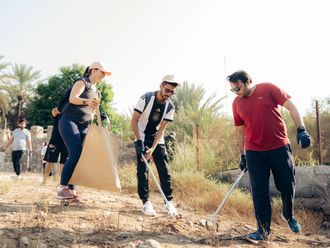Archaeologists have discovered the remains of the earliest known inhabitant of the emirate. The human skeleton was found placed on a stone platform, the Abu Dhabi Islands Archaeological Survey (Adias) announced yesterday.
The skeleton had been disturbed, perhaps because of the collapse of the stone walls and roof of the structure which housed it, its feet being found 2.5 metres from the rest of the body, the report said.
Archaeologists have found remains of the earliest known inhabitant of Abu Dhabi in the western island of Marawah. |
The excavations were carried out at the site of a 7,000-year-old village which has the best-preserved and most sophisticated stone buildings from the Neolithic period in eastern Arabia.
Radiocarbon dating indicates the inside upper layers of the building are 6,500 to 7,000 years old.
"The results of this year's excavations underline Marawah MPA as an area of importance both for the marine life of the UAE and for the way man made use of the marine resources thousands of years ago," said Adias executive director Peter Hellyer, while praising the agency for its support.
"Thanks to the help provided by Erwda, we have been able to continue our investigations of this important island, now clearly established as one of the most important sites both for environmental conservation and archaeology anywhere in the lower Arabian Gulf."
Directed by Dr Mark Beech, the Adias senior resident archaeologist, and with team members from the Birmingham Archaeology Unit in Britain and UAE archaeologist Mohammed Hassan, the excavations took place over a five-week period in March and early April.
The work on the site, named MR-11, focused on the detailed excavation of a building that was first identified during earlier Adias fieldwork.
It was built in at least three phases, and contains at least four rooms, one of which has been completely excavated.
About 4.6 metres long and 1.8 metres wide, the room had well-built walls that were constructed using a double-skin method, large stones first being placed as inner and outer layers, and smaller stones being used to fill the cavity.
Although known from the Bronze Age, which began a couple of thousand years later, this method had not previously been identified on Neolithic sites in eastern Arabia.
Nearby are at least three more rooms, yet to be fully examined.
A look into the past
* Excavations carried out at the site of a 7,000-year-old village in Abu Dhabi resulted in the
discovery of the oldest human remains in the emirate.
* Archaeologists also stumbled upon fragments of a decorated pot which provides evidence that the Neolithic inhabitants of Marawah were trading by sea with southern Mesopotamia.
* A sample of the pot has been sent to France's Centre Nationale pour les Recherches Scientifiques for further study.
* Also found during the excavation were fragments of plaster vessels, some of which were painted.
* A small collection of flint tools was also found as well as more than 100 beads, fish, dugong and turtle bones, and bones from either sheep or goats. Of particular interest were two beautiful and delicate buttons made from pearl oyster shells.










